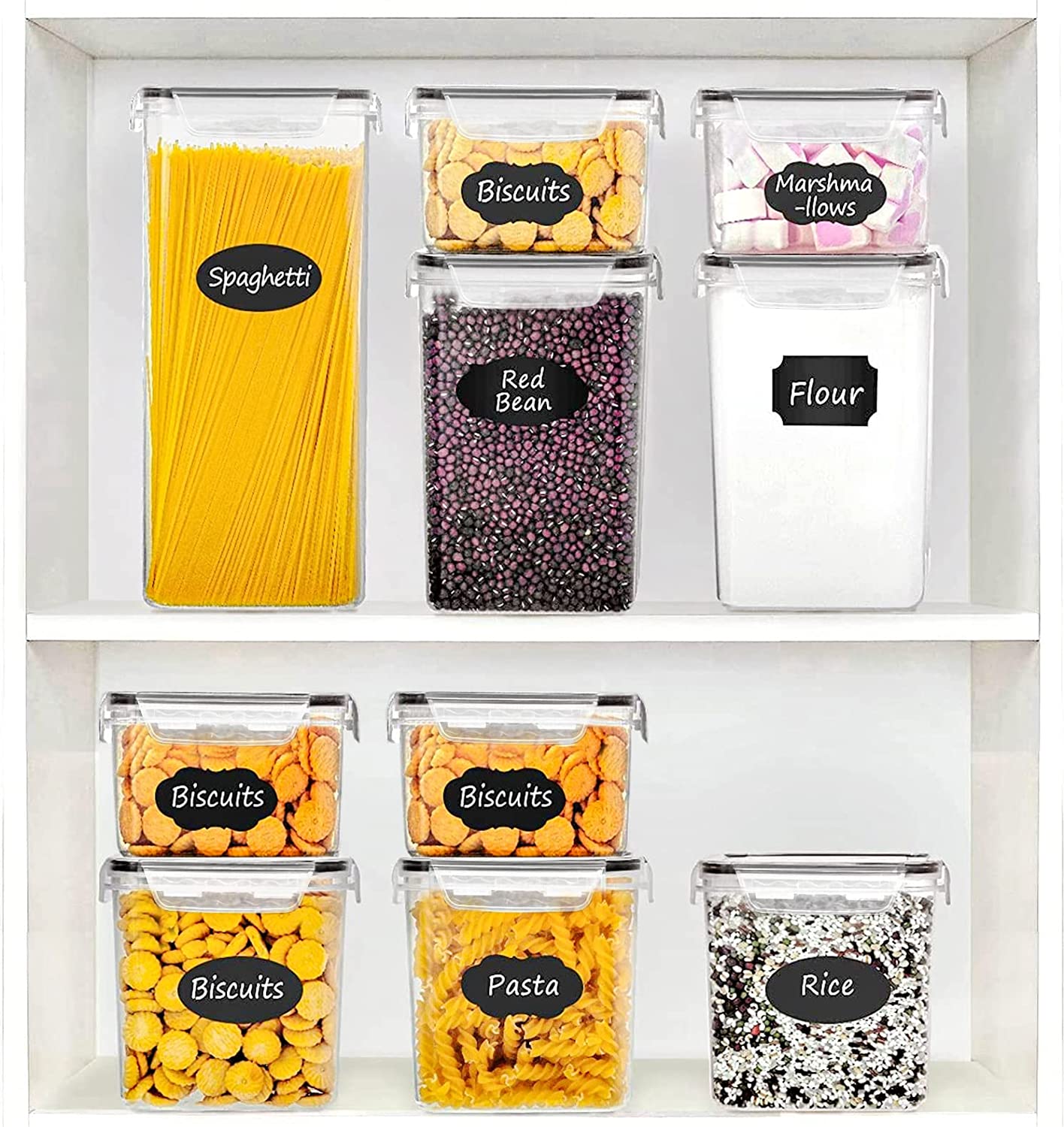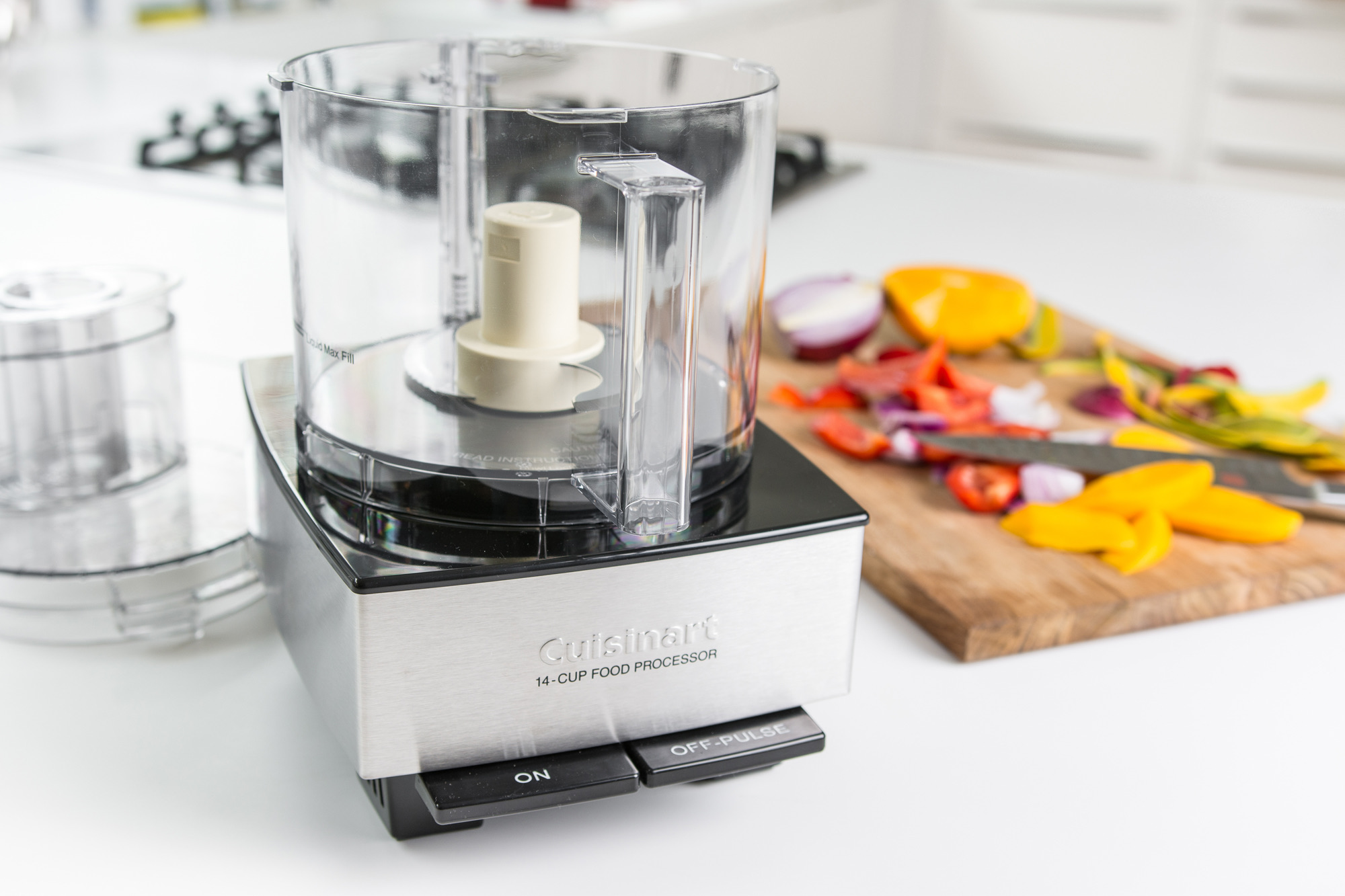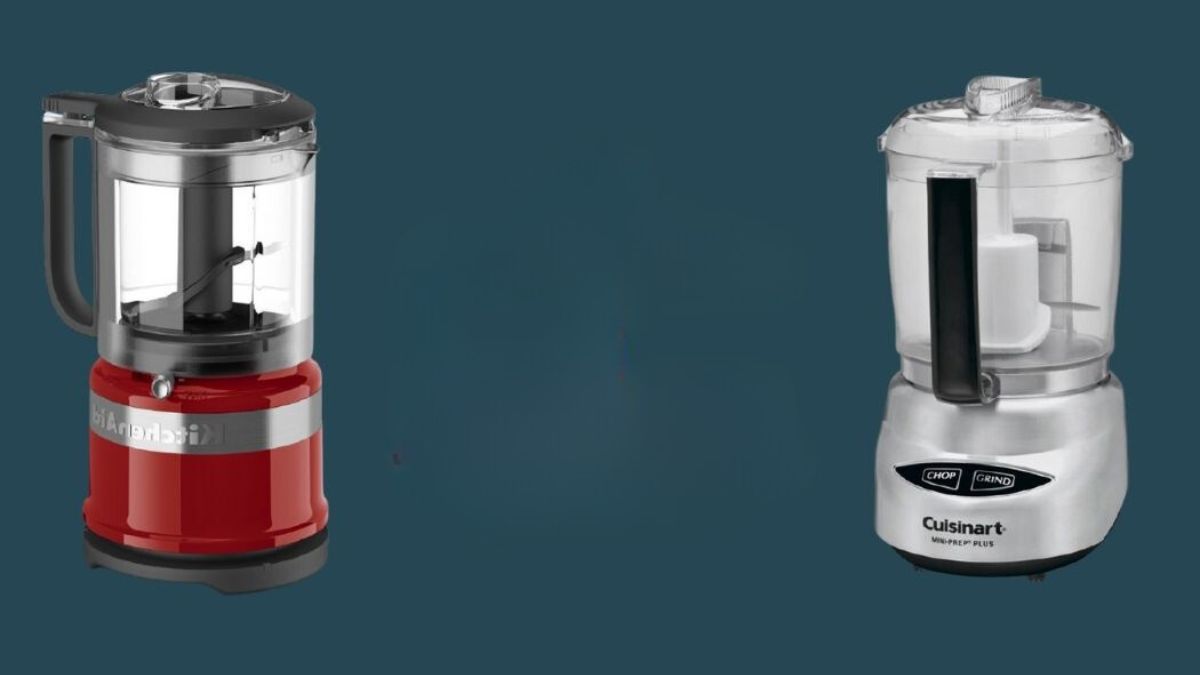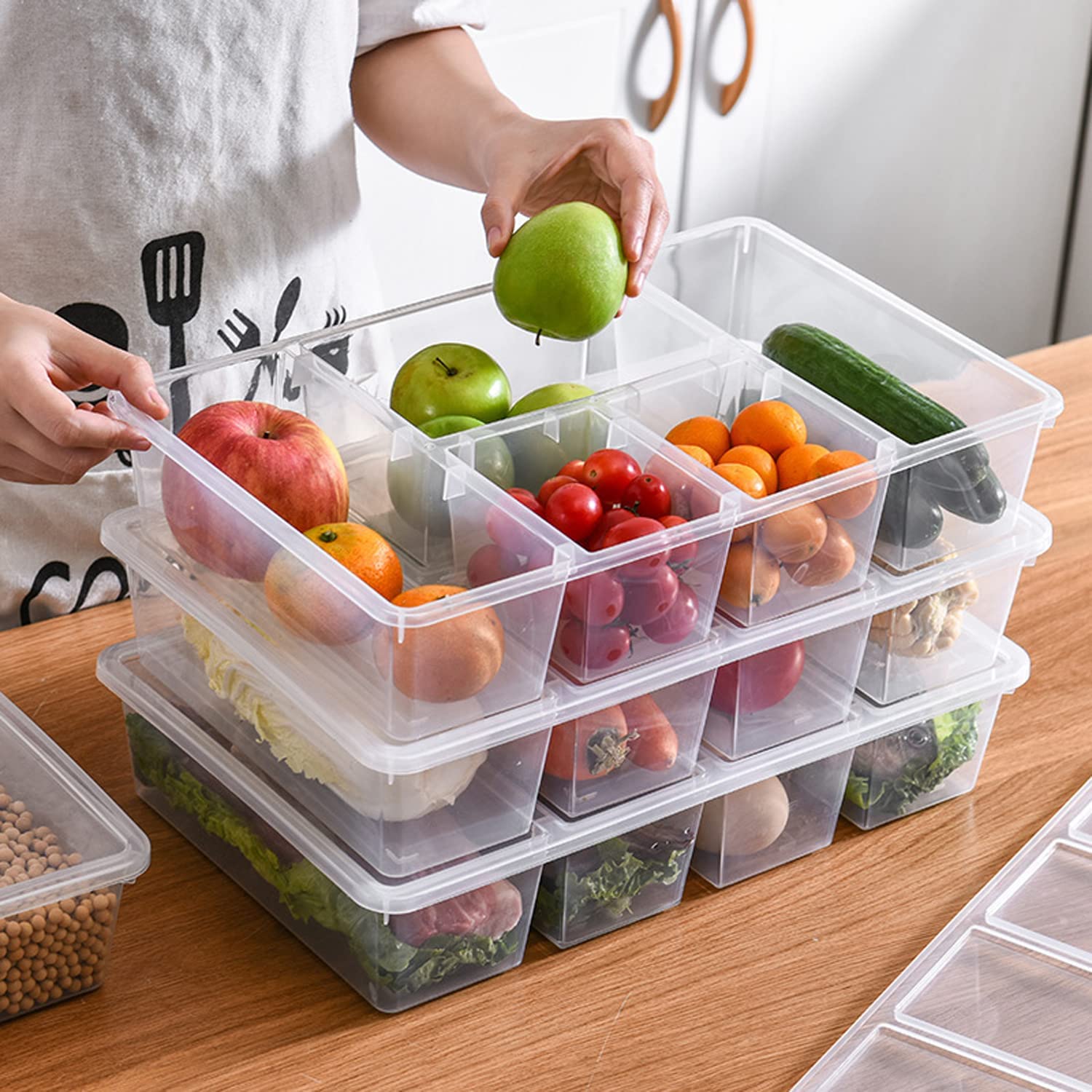Home>Articles>Which Of The Following Food Containers Must Be Labeled


Articles
Which Of The Following Food Containers Must Be Labeled
Modified: October 28, 2024
Find out which pantry storage containers must be labeled for easy organization. Discover the best options for keeping your food fresh and organized in your pantry.
(Many of the links in this article redirect to a specific reviewed product. Your purchase of these products through affiliate links helps to generate commission for Storables.com, at no extra cost. Learn more)
Introduction
Food container labeling is an essential aspect of the food industry. It provides vital information to consumers about the contents, ingredients, nutritional facts, and storage instructions of the food products they purchase. This information helps consumers make informed decisions based on their dietary needs, allergies, and preferences.
In recent years, there has been an increased focus on food safety and transparency. Food container labeling plays a significant role in ensuring that consumers have access to accurate information about the food products they buy. This article will delve into the importance of labeling food containers and provide an overview of the types of food containers that must be labeled.
Proper labeling of food containers goes beyond just providing basic information; it also helps with brand recognition and consumer trust. When consumers see a well-labeled food container, they can easily identify the product and brand. This helps in building brand loyalty and fostering repeat customers.
Furthermore, food container labeling is crucial for individuals with dietary restrictions or specific nutritional requirements. By clearly stating ingredients and nutritional facts, labeling helps people make informed decisions about what they can consume.
Now, let us explore the various types of food containers that must be properly labeled to meet legal requirements and ensure consumer safety.
Key Takeaways:
- Proper labeling of food containers is crucial for ensuring consumer safety, promoting transparency, and enabling informed decision-making based on dietary needs, restrictions, and preferences.
- Clear and accurate labeling on various types of food containers, including glass, paper, plastic, metal, biodegradable, and Styrofoam, is essential for building consumer trust, loyalty, and satisfaction while contributing to a sustainable and responsible food industry.
Background on Food Container Labeling
In many countries, there are regulations and guidelines in place that mandate food container labeling. These regulations are put in place to protect consumer health and safety, as well as to prevent misleading or false information about food products.
Food container labeling includes a range of information that must be clearly displayed on the packaging. This information typically includes the product name, list of ingredients, nutritional information, allergen warnings, storage instructions, and any applicable dates such as the manufacturing date, best before date, or expiry date.
The regulations and requirements for food container labeling can vary from country to country and even from state to state. It is important for food manufacturers and distributors to adhere to these regulations to avoid penalties or legal consequences.
Food container labeling can be a complex process, as it requires compliance with various standards and guidelines set by regulatory authorities. These regulations aim to ensure that consumers have access to accurate and transparent information about the food products they purchase, promoting consumer trust and safety.
Moreover, food container labeling serves as a means of communication between the food producer and the consumer. It allows manufacturers to provide information about the quality, sourcing, and nutritional value of their products, giving consumers the confidence to make informed choices.
In recent years, there has been a growing demand for more detailed and informative food labeling. This has led to additional requirements for labeling genetically modified organisms (GMOs), country of origin, sustainability, and organic certifications. These additional labeling requirements further assist consumers in making conscious and ethical purchasing decisions.
It is worth mentioning that the rise of e-commerce and online food retail has presented new challenges for food container labeling. Packaging and labeling must now also be suitable for online sales, where consumers may not have the opportunity to physically examine the product before making a purchase.
Overall, food container labeling serves as a crucial tool in protecting consumer rights, promoting product transparency, and enabling informed decision-making. The next section will discuss the types of food containers that must be labeled to ensure compliance with these regulations.
Importance of Labeling Food Containers
Labeling food containers plays a vital role in ensuring consumer safety, promoting transparency, and enabling informed decision-making. Here are some key reasons why labeling food containers is of utmost importance:
1. Food Safety: Proper labeling of food containers helps to ensure the safety of consumers. It allows individuals to identify potential allergens and avoid ingredients that may cause adverse reactions. Clear labeling also helps to prevent cross-contamination and assists in the proper storage and handling of food products.
2. Allergen Awareness: Food allergies are a serious concern for many individuals. Including allergen warnings on food container labels helps consumers identify if a particular product contains ingredients they need to avoid. This is crucial in preventing allergic reactions and safeguarding the health of affected individuals.
3. Nutritional Information: Labeling food containers with nutritional information allows consumers to make informed choices based on their dietary needs. It helps individuals monitor calorie intake, track macronutrients, and identify the nutritional value of the product. This is particularly important for individuals with specific dietary requirements or those striving to maintain a healthy lifestyle.
4. Dietary Restrictions: Food container labels are indispensable for individuals with dietary restrictions, such as vegetarians, vegans, or those with religious dietary practices. By clearly indicating the ingredients used in a product, individuals can determine if it aligns with their dietary preferences or restrictions.
5. Ingredient Transparency: Labeling food containers enhances transparency by providing consumers with complete information about the ingredients used in a product. This allows individuals to make conscious choices based on their personal preferences or dietary concerns, such as avoiding additives, preservatives, or artificial flavors and colors.
6. Product Identification: Proper labeling helps consumers easily identify the product and brand. It enables consumers to quickly recognize familiar products and fosters trust and brand loyalty. Clear and consistent branding on food containers contributes to a positive consumer experience.
7. Legal Compliance: Compliance with food container labeling regulations is crucial for businesses to avoid legal issues and penalties. Proper labeling ensures that businesses meet the requirements set by regulatory authorities and protect consumers’ rights to accurate information.
8. Sustainability and Ethical Concerns: With an increasing focus on sustainability and ethical sourcing, labeling allows individuals to make informed choices aligned with their values. Labels indicating organic certifications, fair trade practices, or eco-friendly packaging help consumers support products and companies that prioritize these issues.
Overall, labeling food containers is essential for ensuring consumer safety, facilitating informed decision-making, and promoting transparency and trust in the food industry.
Types of Food Containers That Must Be Labeled
Various types of food containers must be properly labeled to comply with labeling regulations and ensure consumer safety. Let’s explore some of the most common types:
1. Glass Containers:
Glass containers, such as jars and bottles, are commonly used for packaging food products. They must be labeled to provide important information such as the product name, list of ingredients, nutritional facts, allergen warnings, and storage instructions. The label should be securely attached to the container and remain legible throughout the product’s shelf life.
Read more: Which Printer Is Best For Label Printing?
2. Paper Containers:
Paper containers, including boxes, bags, and cartons, are prevalent in the food industry. These containers must be labeled with relevant information to inform consumers about the contents, nutritional value, potential allergens, and handling instructions. It is crucial to choose labels that adhere well to the surface of paper containers to prevent them from peeling or getting damaged.
3. Plastic Containers:
Plastic containers come in various forms, such as bottles, tubs, and pouches. They are widely used for packaging food products due to their versatility and durability. Labels on plastic containers should be resistant to moisture and remain intact throughout the product’s lifespan. Important information, including ingredient lists, nutritional information, and storage instructions, should be clearly displayed on the label.
4. Metal Containers:
Metal containers, like cans and tins, are commonly used for preserving a wide range of food products. These containers must be properly labeled to provide consumers with essential information, including the product name, ingredient list, nutritional details, and any necessary warnings. Labels on metal containers should be designed to resist fading, peeling, or becoming illegible due to the metal’s properties.
5. Biodegradable Containers:
With the growing emphasis on sustainability, biodegradable food containers have gained popularity. These containers, typically made from materials like bioplastics or plant-derived fibers, must also be labeled. The labels should clearly indicate the product information, such as ingredients, allergen warnings, and disposal instructions. The labels should be compatible with the biodegradable nature of the containers.
6. Styrofoam Containers:
Styrofoam containers, although widely used, have raised concerns due to their environmental impact. Depending on local regulations, the labeling requirements for styrofoam containers may vary. However, it is advisable to provide essential information on these containers, such as the product name, nutritional information, and any necessary warnings. Businesses should consider more eco-friendly alternatives to styrofoam whenever possible.
It is important to note that the specific labeling requirements for each type of food container can vary depending on regional regulations and the nature of the product being packaged. It is crucial for food producers and suppliers to understand and comply with the labeling guidelines specific to their jurisdiction to ensure consumer safety and legal compliance.
By properly labeling different types of food containers, manufacturers can provide consumers with the necessary information to make informed choices about the products they purchase while ensuring regulatory compliance.
Glass Containers
Glass containers, such as jars and bottles, are widely used in the food industry for packaging various products like sauces, preserves, beverages, and condiments. These containers provide several benefits, including transparency, versatility, and an airtight seal. When it comes to labeling glass containers, certain key aspects need to be considered to ensure compliance with regulations and consumer safety.
Product Name: The label on a glass container should clearly display the product name or brand. This helps consumers easily identify the contents of the container and distinguish it from other similar products on the shelf. The product name should be prominently displayed on the front of the label using legible fonts and appropriate typography.
Ingredient List: Glass containers must include a comprehensive list of ingredients used in the product. This is especially important for individuals with allergies or dietary restrictions who need to avoid specific ingredients. The ingredient list should be clear and easily readable, providing transparency about the components of the product.
Nutritional Facts: Glass containers should also provide nutritional information to help consumers make informed decisions based on their dietary needs. This includes details such as serving size, calories, fat content, carbohydrates, protein, vitamins, and minerals. The nutritional facts should be presented in a concise and organized manner, often in a standard format per serving size.
Allergen Warnings: If the product contains common allergens like nuts, dairy, or gluten, glass containers must clearly display allergen warnings. This allows individuals with specific allergies to identify potential allergens and avoid consuming products that may cause adverse reactions. The allergen warnings should be easily visible, potentially highlighted or in bold font, to ensure consumer safety.
Storage Instructions: Proper storage is crucial for maintaining the quality and freshness of the product. Glass containers should provide clear storage instructions, such as recommended temperature, refrigeration requirements, and expiration dates. This information helps consumers store the product correctly to prevent spoilage or contamination.
Label Material and Adherence: When labeling glass containers, it’s important to choose label materials that adhere well to glass surfaces and remain intact throughout the product’s shelf life. The label material should be resistant to moisture, heat, and fading, ensuring that the information on the label remains legible and accurate.
Regulatory Compliance: Businesses must ensure that labeling on glass containers complies with relevant local, state, and national regulations. These regulations may differ from one jurisdiction to another, so it is important to stay up-to-date on specific requirements and make any necessary updates to labels accordingly.
Proper labeling of glass containers not only ensures regulatory compliance but also helps consumers make informed decisions about the products they purchase. Detailed and accurate labeling on glass containers promotes transparency, enhances brand recognition, and establishes trust with consumers, ultimately contributing to a positive consumer experience.
Paper Containers
Paper containers, including boxes, bags, and cartons, are commonly used in the food industry for packaging a wide range of products such as baked goods, snacks, grains, and dry ingredients. Labeling paper containers is essential to provide consumers with important information about the contents, handling instructions, and potential allergens. Here are key points to consider when labeling paper containers:
Product and Brand Identification: The label on a paper container should prominently display the product name and brand. This helps consumers easily identify the specific product they are looking for and build brand recognition. The product name and brand should be placed prominently on the front of the label using legible fonts and appropriate colors.
Ingredient List: Paper containers must include a comprehensive list of ingredients used in the product. This allows consumers to be aware of the components and potential allergens present in the food item. The ingredient list should be clear and easy to read, ensuring transparency and providing vital information to those with dietary restrictions or allergies.
Nutritional Information: Including nutritional facts on paper containers allows consumers to make informed choices based on their dietary needs. This information typically includes serving size, calories, fat content, carbohydrates, protein, vitamins, and minerals. The nutritional information should be presented in a clear and organized manner, guiding consumers’ decision-making process.
Allergen Warnings: If the product contains common allergens such as nuts, dairy, or gluten, paper containers must clearly display allergen warnings. This is crucial for individuals with food allergies or sensitivities who need to avoid specific ingredients. The allergen warnings should be easily visible and should stand out, potentially using bold or contrasting fonts, to ensure consumer safety.
Handling and Storage Instructions: Proper handling and storage are important for maintaining the freshness and quality of food products. Paper containers should provide clear instructions on how to handle and store the product, including recommended temperature, storage conditions, and expiration dates. This information assists consumers in storing the product correctly, preventing spoilage or contamination.
Sustainable Packaging Claims: If the paper container is made from recycled materials or is marketed as environmentally friendly or sustainable, it is important to include appropriate claims on the label. This may involve using eco-friendly logos and text that highlight the sustainability aspect, helping consumers make choices aligned with their environmental values.
Label Adherence and Durability: When labeling paper containers, it is important to choose label materials that adhere securely to the surface and maintain their integrity throughout the product’s shelf life. The label should be resistant to moisture, smudging, or peeling, ensuring that the information remains visible and legible until the consumer uses the product.
Regulatory Compliance: Businesses must ensure that labeling on paper containers complies with relevant local, state, and national regulations. These regulations may vary, so it is important to stay informed and update labels accordingly to meet any specific requirements.
Proper labeling of paper containers not only ensures regulatory compliance but also provides consumers with the necessary information to make informed decisions about the food products they purchase. Clear and accurate labeling on paper containers helps consumers understand the contents, allergens, nutritional value, and proper handling instructions, ultimately promoting transparency and consumer satisfaction.
Plastic Containers
Plastic containers are widely used in the food industry for packaging various products such as beverages, snacks, sauces, and deli items. These containers offer convenience, durability, and versatility. When it comes to labeling plastic containers, it is crucial to provide consumers with important information while ensuring compliance with regulations and maintaining the integrity of the label. Here are key considerations when labeling plastic containers:
Product Identification: The label on a plastic container should clearly display the product name and brand. This allows consumers to easily identify the specific product they are looking for and fosters brand recognition. The product name and brand should be prominently placed on the front of the label, using legible fonts and appropriate colors.
Ingredient List: Plastic containers must include a comprehensive list of ingredients used in the product. This is essential for individuals with dietary restrictions or allergies who need to avoid specific ingredients. The ingredient list should be clear and easily readable, providing transparency and ensuring consumer safety.
Nutritional Information: Including nutritional facts on plastic containers helps consumers make informed decisions based on their dietary needs. This information typically includes serving size, calories, fat content, carbohydrates, protein, vitamins, and minerals. The nutritional information should be presented in a clear and organized manner, guiding consumers’ understanding of the product’s nutritional value.
Allergen Warnings: If the product contains common allergens such as nuts, dairy, or gluten, plastic containers must clearly display allergen warnings. This is crucial for individuals with food allergies or sensitivities. The allergen warnings should be easily visible and stand out, potentially using bold or contrasting fonts, to ensure consumer safety.
Storage Instructions: Proper storage is important for maintaining the freshness and quality of food products. Plastic containers should provide clear instructions on how to handle and store the product, including recommended temperature, storage conditions, and expiration dates. This information helps consumers store the product correctly, preventing spoilage or contamination.
Logo and Recycling Symbols: Plastic containers should include appropriate symbols and logos indicating the type of plastic used and recycling information. These symbols help consumers understand the environmental impact of the container and encourage recycling practices.
Label Durability: When labeling plastic containers, it is essential to choose label materials that adhere well to plastic surfaces and maintain their integrity throughout the product’s shelf life. The label should be resistant to moisture, fading, or peeling, ensuring that the information remains visible and legible until the consumer uses the product.
Regulatory Compliance: Businesses must ensure that labeling on plastic containers adheres to relevant local, state, and national regulations. These regulations may vary, so it is important to stay informed and update labels accordingly to meet specific requirements.
Proper labeling of plastic containers provides consumers with the necessary information to make informed decisions about the food products they purchase. Clear and accurate labeling on plastic containers promotes transparency, assists individuals with dietary restrictions or allergies, and ensures consumer safety and satisfaction.
Metal Containers
Metal containers, such as cans and tins, are commonly used in the food industry for packaging a variety of products, including fruits, vegetables, soups, and pet foods. These containers offer durability, protection, and a long shelf life for the enclosed food items. When it comes to labeling metal containers, there are several important considerations to ensure compliance with regulations and provide consumers with relevant information.
Product Identification: The label on a metal container should prominently display the product name and brand. This helps consumers easily identify the specific product they are looking for and establishes brand recognition. The product name and brand should be placed prominently on the front of the label, using legible fonts and appropriate colors.
Ingredient List: Metal containers must include a comprehensive list of ingredients used in the product. This is important for individuals with dietary restrictions or allergies who need to avoid specific ingredients. The ingredient list should be clear and easily readable, providing transparency about the components of the product.
Nutritional Information: Including nutritional facts on metal containers allows consumers to make informed choices based on their dietary needs. This information typically includes serving size, calories, fat content, carbohydrates, protein, vitamins, and minerals. The nutritional information should be presented in a clear and organized manner, aiding consumers in understanding the nutritional value of the product.
Allergen Warnings: If the product contains common allergens such as nuts, dairy, or gluten, metal containers must prominently display allergen warnings. This is crucial for individuals with food allergies or sensitivities. The allergen warnings should be easily visible, potentially using bold or contrasting fonts, to ensure consumer safety and prevent allergic reactions.
Storage Instructions: Proper storage is essential for maintaining the quality and freshness of food products. Metal containers should provide clear instructions on how to handle and store the product, including recommended temperature, storage conditions, and expiration dates. This information helps consumers store the product correctly, preventing spoilage and ensuring optimal taste and safety.
Label Durability: When labeling metal containers, it is important to choose label materials that adhere securely to the surface and withstand external factors such as moisture, temperature variations, and handling during transportation. The label should be resistant to fading, peeling, or getting damaged, ensuring that the information remains visible and legible throughout the product’s shelf life.
Regulatory Compliance: Businesses must ensure that labeling on metal containers complies with relevant local, state, and national regulations. These regulations may vary, so it is crucial to stay informed and update labels accordingly to meet specific requirements.
Proper labeling of metal containers provides consumers with the necessary information to make informed decisions about the food products they purchase. Clear and accurate labeling on metal containers promotes transparency, assists individuals with dietary restrictions or allergies, and ensures consumer safety and satisfaction.
Biodegradable Containers
Biodegradable containers, made from materials like bioplastics or plant-derived fibers, have gained popularity in recent years due to their eco-friendly nature and reduced impact on the environment. These containers provide a sustainable alternative to traditional packaging materials. When it comes to labeling biodegradable containers, there are specific considerations to ensure compliance with regulations and provide consumers with accurate information.
Product Identification: The label on a biodegradable container should prominently display the product name and brand. This helps consumers easily identify the specific product they are looking for and fosters brand recognition. The product name and brand should be placed prominently on the front of the label, using legible fonts and appropriate colors.
Ingredient List: Biodegradable containers must include a comprehensive list of ingredients used in the product. This is important for individuals with dietary restrictions or allergies. The ingredient list should be clear and easily readable, providing transparency about the components of the product.
Nutritional Information: Including nutritional facts on biodegradable containers allows consumers to make informed choices based on their dietary needs. This information typically includes serving size, calories, fat content, carbohydrates, protein, vitamins, and minerals. The nutritional information should be presented in a clear and organized manner, supporting consumers in understanding the nutritional value of the product.
Allergen Warnings: If the product in the biodegradable container contains common allergens such as nuts, dairy, or gluten, it is important to prominently display allergen warnings. This is crucial for individuals with food allergies or sensitivities. The allergen warnings should be easily visible, potentially using bold or contrasting fonts, to ensure consumer safety.
Disposal Instructions: Biodegradable containers should provide clear instructions on how to dispose of them properly. This information helps consumers understand the environmentally friendly nature of the packaging and encourages responsible disposal practices. It may include details about composting, recycling, or other eco-friendly disposal methods.
Sustainability Claims and Certifications: Biodegradable containers often carry sustainability claims and certifications, such as “Certified Compostable” or “Made from Renewable Resources.” The label should include appropriate logos or text to highlight the product’s eco-friendly attributes, helping consumers make choices aligned with their environmental values.
Label Durability and Compatibility: When labeling biodegradable containers, it is important to choose label materials that adhere securely and remain intact throughout the product’s shelf life. The label should be resistant to moisture, fading, or peeling to ensure that the information remains visible and legible to consumers.
Regulatory Compliance: Businesses must ensure that labeling on biodegradable containers complies with relevant local, state, and national regulations. These regulations may vary, so it is important to stay informed and update labels accordingly to meet specific requirements.
Proper labeling of biodegradable containers not only ensures compliance with regulations but also provides consumers with the necessary information to make informed choices about the products they purchase. Clear and accurate labeling on biodegradable containers promotes transparency, supports sustainable practices, and aligns with consumers’ environmental concerns.
All food containers that are not in their original packaging must be labeled with the contents and date of preparation to ensure food safety and proper storage.
Styrofoam Containers
Styrofoam containers, although widely used in the food industry for their insulating properties, have raised concerns due to their environmental impact. While the use of Styrofoam containers is being phased out by many businesses and jurisdictions in favor of more sustainable alternatives, it is important to address the labeling considerations for these containers which are still in use:
Product Identification: The label on a Styrofoam container should prominently display the product name and brand. This makes it easy for consumers to identify the specific product they are looking for and establishes brand recognition. The product name and brand should be placed prominently on the front of the label, using legible fonts and appropriate colors.
Ingredient List: Styrofoam containers must include a comprehensive list of ingredients used in the product. This information is important for individuals with dietary restrictions or allergies. The ingredient list should be clear and easily readable, providing transparency about the components of the product inside the container.
Nutritional Information: Including nutritional facts on Styrofoam containers enables consumers to make informed choices based on their dietary needs. Key nutritional information, such as serving size, calories, fat content, carbohydrates, protein, vitamins, and minerals, should be presented in a clear and organized manner.
Allergen Warnings: If the product in the Styrofoam container contains common allergens such as nuts, dairy, or gluten, it is crucial to prominently display allergen warnings. This is important for individuals with food allergies or sensitivities. The allergen warnings should be easily visible, potentially using bold or contrasting fonts, to ensure consumer safety.
Storage Instructions: Proper storage is important for maintaining the quality and safety of food products. Styrofoam containers should provide clear instructions on how to handle and store the product, including recommended temperature, storage conditions, and expiration dates. This information helps consumers store the product correctly and preserve its freshness.
Environmental Impact Information: While Styrofoam containers are not considered environmentally friendly, businesses can use labels to provide information about the material’s impact. This may involve displaying symbols or text indicating that the container is not biodegradable or encouraging consumers to consider more sustainable alternatives.
Regulatory Compliance: Businesses must ensure that labeling on Styrofoam containers complies with relevant local, state, and national regulations. These regulations may vary, so it is important to stay informed and update labels accordingly to meet specific requirements.
As businesses and consumers are increasingly concerned about the environmental impact of Styrofoam, it is advisable to explore and transition to more sustainable packaging alternatives whenever possible.
Proper labeling of Styrofoam containers not only ensures regulatory compliance but also provides consumers with the necessary information to make informed choices about the products they purchase. It promotes transparency, assists individuals with dietary restrictions or allergies, and encourages businesses to consider more sustainable packaging options in the long run.
Exceptions to Labeling Requirements
While proper labeling of food containers is generally a requirement in many jurisdictions, there are some exceptions to these labeling requirements. These exceptions may vary depending on regional regulations and the specific nature of the food product or container. Here are some common exceptions to labeling requirements:
Small Businesses: Some regulations may provide exemptions or reduced labeling requirements for small businesses that meet specific criteria. This is often done to reduce the burden on smaller-scale operations while still ensuring essential information is provided to consumers. However, it is important for small businesses to understand the applicable regulations in their jurisdiction to determine if they qualify for any exemptions.
Food Sold in Bulk: Certain regulations may exempt foods sold in bulk from certain labeling requirements. This includes products sold loose, without packaging, or where the container is not accessible to the consumer at the point of sale. However, there may still be requirements for labeling or providing information in close proximity to the bulk display to ensure consumers have access to necessary information.
Ready-to-Eat Foods: In some cases, certain ready-to-eat foods, such as individual servings of fruits and vegetables, may be exempt from certain labeling requirements. This exemption may be based on the premise that the food item itself is readily identifiable and the need for detailed labeling is minimal. However, basic information such as allergen warnings and nutritional information may still be required.
Food Prepared and Sold on-Site: Food prepared and sold on-site, such as at restaurants, food trucks, or bakeries, may have different labeling requirements compared to pre-packaged food items. As these foods are typically consumed immediately or shortly after preparation, the labeling may focus more on allergen warnings and may not require the same level of detailed information as pre-packaged food.
Products with Limited Shelf Life: Some regulations may have specific exemptions for products with a very short shelf life, such as certain types of baked goods or perishable items. These exemptions recognize that there may not be sufficient time for full labeling and that providing information at the point of sale, such as a sign or label display, is more practical.
Custom-Made or Specialty Orders: Regulations may have exceptions for custom-made or specialty orders where the product is uniquely created or modified based on specific customer requests. The exemption recognizes that it may not be feasible to provide complete labeling for highly customized products and that the necessary information can be provided through other means, such as detailed communications with the customer.
It is important for businesses to familiarize themselves with the specific labeling exemptions and exceptions relevant to their jurisdiction and industry. Additionally, it is crucial to ensure that despite any exemptions, businesses still prioritize consumer safety by providing accurate and relevant information whenever possible.
While exceptions to labeling requirements exist, the overall goal of food container labeling is to provide consumers with necessary information about the products they purchase. This transparency empowers consumers to make informed choices based on their dietary needs, preferences, and safety considerations.
Conclusion
Labeling food containers is a crucial aspect of the food industry, providing essential information to consumers about the products they purchase. Proper labeling ensures consumer safety, promotes transparency, and enables informed decision-making. Whether it’s glass, paper, plastic, metal, biodegradable, or even Styrofoam containers, each type has specific considerations for labeling in compliance with regulations.
From clearly displaying product names and brands to providing comprehensive ingredient lists, nutritional information, and allergen warnings, labeling helps consumers make informed choices based on their dietary needs, restrictions, and preferences. Proper storage instructions on food containers also guide consumers in maintaining product quality and safety.
Labeling not only serves practical purposes but also contributes to brand recognition, consumer trust, and loyalty. It helps consumers easily identify their favorite products and fosters a positive consumer experience.
While there are exceptions to labeling requirements, such as those for small businesses or products sold in bulk, it is important for businesses to understand the applicable regulations in their jurisdiction and strive to provide as much information as possible to consumers. Clear and accurate labeling ensures that consumers have access to the information they need to make informed decisions about the food products they purchase.
As the focus on sustainability and eco-friendly practices grows, businesses are increasingly exploring alternatives, such as biodegradable containers, to reduce environmental impact. Labeling on these containers plays a crucial role in highlighting their sustainable attributes and encouraging responsible disposal practices.
In conclusion, proper labeling of food containers is essential for consumer safety, transparency, and informed decision-making. By adhering to labeling regulations and providing accurate and comprehensive information, businesses can build trust, loyalty, and consumer satisfaction, while contributing to a sustainable and responsible food industry.
Frequently Asked Questions about Which Of The Following Food Containers Must Be Labeled
Was this page helpful?
At Storables.com, we guarantee accurate and reliable information. Our content, validated by Expert Board Contributors, is crafted following stringent Editorial Policies. We're committed to providing you with well-researched, expert-backed insights for all your informational needs.












0 thoughts on “Which Of The Following Food Containers Must Be Labeled”